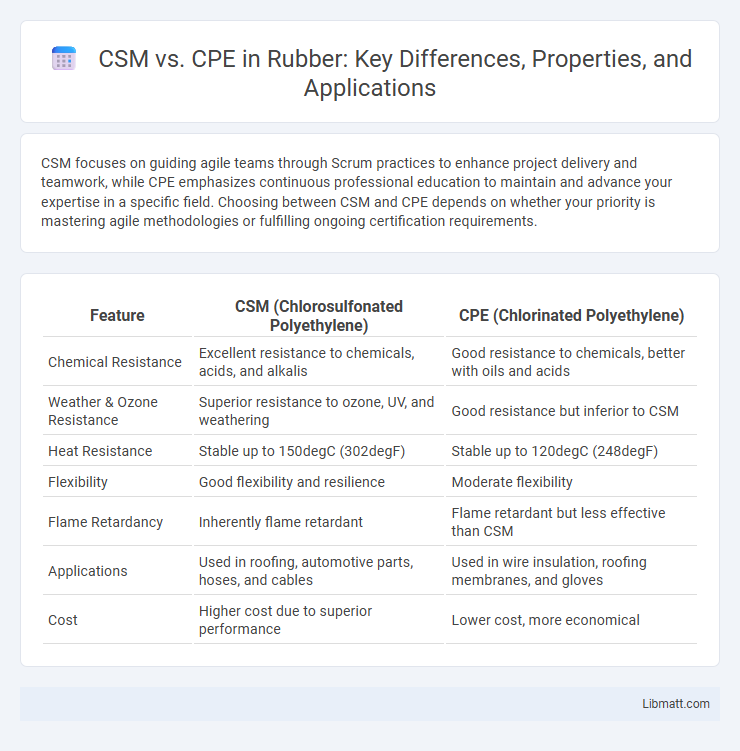CSM focuses on guiding agile teams through Scrum practices to enhance project delivery and teamwork, while CPE emphasizes continuous professional education to maintain and advance your expertise in a specific field. Choosing between CSM and CPE depends on whether your priority is mastering agile methodologies or fulfilling ongoing certification requirements.
Table of Comparison
| Feature | CSM (Chlorosulfonated Polyethylene) | CPE (Chlorinated Polyethylene) |
|---|---|---|
| Chemical Resistance | Excellent resistance to chemicals, acids, and alkalis | Good resistance to chemicals, better with oils and acids |
| Weather & Ozone Resistance | Superior resistance to ozone, UV, and weathering | Good resistance but inferior to CSM |
| Heat Resistance | Stable up to 150degC (302degF) | Stable up to 120degC (248degF) |
| Flexibility | Good flexibility and resilience | Moderate flexibility |
| Flame Retardancy | Inherently flame retardant | Flame retardant but less effective than CSM |
| Applications | Used in roofing, automotive parts, hoses, and cables | Used in wire insulation, roofing membranes, and gloves |
| Cost | Higher cost due to superior performance | Lower cost, more economical |
Introduction to CSM and CPE
Customer Success Management (CSM) focuses on ensuring clients achieve desired outcomes with a product or service, emphasizing proactive support and long-term relationship building. Customer Premises Equipment (CPE) refers to telecommunications hardware located at the customer's site, enabling access to network services and infrastructure. Both CSM and CPE are critical for optimizing customer experience and network performance in tech-driven industries.
Defining CSM: Customer Success Management
Customer Success Management (CSM) focuses on building long-term relationships with customers by ensuring they achieve desired outcomes with a company's products or services. CSM professionals use data-driven strategies to proactively engage clients, reduce churn, and increase customer lifetime value. This approach emphasizes customer satisfaction, adoption, and retention through personalized support and success planning.
Defining CPE: Customer Product Engagement
Customer Product Engagement (CPE) measures how actively customers interact with a product, reflecting usage patterns and satisfaction levels. It provides insights into product adoption, feature utilization, and ongoing value perception, enabling businesses to tailor improvements and support. Tracking CPE helps optimize customer experience, increase retention, and drive product-driven growth by aligning offerings with user needs.
Key Differences Between CSM and CPE
Customer Service Management (CSM) focuses on optimizing customer interactions and support processes using tools like ServiceNow to enhance customer satisfaction and operational efficiency. Customer Premises Equipment (CPE) refers to physical devices such as routers, modems, and telephones located at the customer's site, essential for establishing connectivity and communication services. The key difference lies in CSM being a service management strategy and software solution, while CPE is tangible hardware deployed in the customer environment.
Roles and Responsibilities: CSM vs CPE
Customer Success Managers (CSMs) primarily focus on driving customer satisfaction, adoption, and retention by proactively managing client relationships and ensuring product value realization. Customer Product Experts (CPEs) specialize in providing deep technical expertise, troubleshooting complex issues, and delivering product training or insights to optimize customer usage. While CSMs act as strategic partners facilitating customer growth, CPEs serve as technical advisors supporting product implementation and problem resolution.
Impact on Customer Experience
Customer Success Managers (CSMs) directly influence customer experience by providing personalized support, proactive guidance, and ensuring customers achieve their desired outcomes. Customer Premises Equipment (CPE) affects customer experience through the reliability and performance of hardware located at the customer's site, impacting service quality and connectivity. The synergy between effective CSM strategies and robust CPE deployments drives higher customer satisfaction and loyalty.
Required Skills for CSM and CPE Professionals
CSM professionals require strong communication, leadership, and customer relationship management skills to effectively guide clients through product adoption and retention processes. CPE specialists must possess in-depth technical expertise, data analysis capabilities, and problem-solving skills to optimize customer experience through personalized engagement and technology integration. Both roles demand adaptability and proficiency in understanding customer needs, but CSM emphasizes strategic relationship management while CPE focuses on technical execution and experiential optimization.
Tools and Technologies for CSM and CPE
Customer Success Management (CSM) leverages tools like Gainsight, Totango, and Salesforce Customer 360 to drive customer retention through data-driven insights and proactive engagement. Customer Premises Equipment (CPE) utilizes technologies such as routers, modems, and specialized hardware integrated with network management systems like Cisco Prime or Huawei iManager for on-site connectivity and performance optimization. Both domains rely heavily on automation and analytics platforms to enhance efficiency--CSM through customer health scoring and CPE through real-time network monitoring.
When to Choose CSM or CPE for Your Business
Choosing between CSM (Customer Success Manager) and CPE (Customer Premises Equipment) depends on your business priorities and infrastructure needs. Opt for CSM when your focus is on enhancing customer experience, retention, and strategic relationship management to drive growth. Select CPE when you require physical networking hardware for on-site connectivity, ensuring control over your telecommunications and data services.
Future Trends: Evolving Roles of CSM and CPE
Future trends indicate that Customer Success Managers (CSMs) will increasingly integrate AI-driven analytics to proactively enhance customer satisfaction, while Customer Premises Equipment (CPE) will evolve with smarter, edge-computing capabilities to support real-time data processing. Your business can leverage the synergy between CSM's strategic customer engagement and CPE's advanced hardware innovations to achieve higher operational efficiency and personalized service delivery. The evolving roles emphasize a seamless blend of human insight and technological advancement to future-proof customer experience management.
CSM vs CPE Infographic

 libmatt.com
libmatt.com